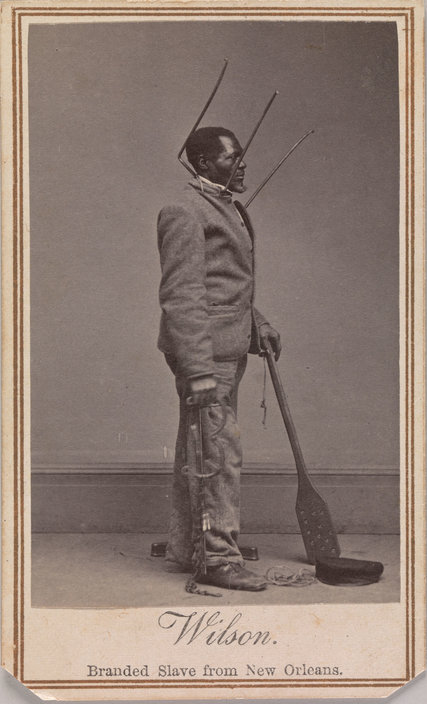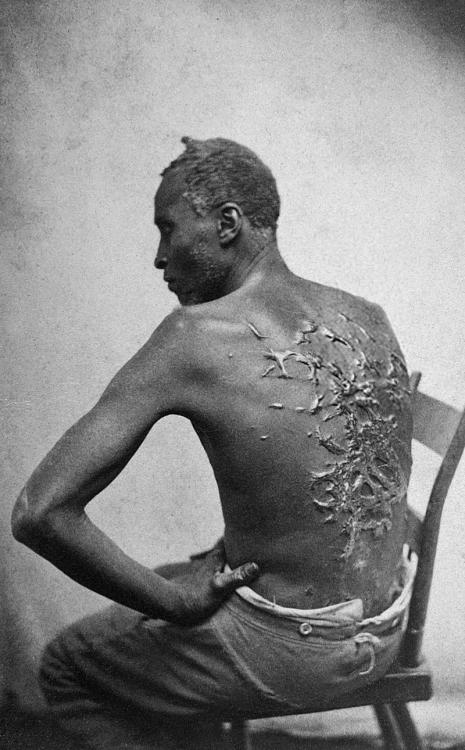-
Posts
3,840 -
Joined
-
Last visited
-
Days Won
119
richardmurray's Achievements
Single Status Update
See all updates by richardmurray
-
Title: Scourged back by McPherson & Oliver, 1863, retouched
Description: Scars of a whipped Mississippi slave, photo taken April 2, 1863, Baton Rouge, Louisiana, USA. Original caption: "Overseer Artayou Carrier whipped me. I was two months in bed sore from the whipping. My master come after I was whipped; he discharged the overseer. The very words of poor Peter, taken as he sat for his picture."
NOTE: The New York Times writer Joan Paulson Gage, noted, "The images of Wilson Chinn in chains, like the one of Gordon and his scarred back, are as disturbing today as they were in 1863. They serve as two of the earliest and most dramatic examples of how the newborn medium of photography could change the course of history." [ read the second article below ]
Will Smith Responds to People Who Reject His Comeback So Soon After Oscars Slap: ‘I Completely Understand’By Zack Sharf
Will Smith’s press tour for “Emancipation” has begun, with the actor directly addressing moviegoers who are not yet ready to embrace his work following the Oscars slap earlier this year. “Emancipation,” a slavery drama directed by Antoine Fuqua, is Smith’s first major film release since the 2022 Oscars, where he took the stage and slapped presenter Chris Rock across the face over a joke made at the expense of Smith’s wife, Jada Pinkett Smith.
“I completely understand — if someone is not ready, I would absolutely respect that and allow them their space to not be ready,” Smith told journalist Kevin McCarthy when asked what he would say to moviegoers who aren’t ready for his comeback. “My deepest concern is my team – Antoine has done what I think is the greatest work of his entire career. The people on this team have done some of the best work of their entire careers, and my deepest hope is that my actions don’t penalize my team. At this point, that’s what I’m working for.”
Smith added, “I’m hoping that the material — the power of the film, the timeliness of the story — I’m hoping that the good that can be done would open people’s hearts at a minimum to see and recognize and support the incredible artists in and around this film.”
“Emancipation” is based on a true story and stars Smith as a runaway slave named Peter, known better to the world as “Whipped Peter” after photographs of keloid scarring on his back were distributed to show the brutality of slavery. The film follows Peter as he navigates the swamps of Louisiana to escape the plantation owners that nearly killed him.
In an interview earlier this month with Vanity Fair, director Antoine Fuqua defended releasing “Emancipation” in the same year as Smith’s Oscars slap.
“The film to me is bigger than that moment,” Fuqua said. “Four hundred years of slavery is bigger than one moment. My hope is that people will see it that way and watch the movie and be swept away with the great performance by Will and all the real hard work that the whole crew did.”
According to Fuqua, committing to release the movie in 2022 was “a full conversation with Apple” but “there was never a conversation with me and Apple or my producers about the movie not coming out.”
“Of course I wanted people to see the film,” Fuqua said. “My conversation was always, ‘Isn’t 400 years of slavery, of brutality, more important than one bad moment?’ We were in Hollywood, and there’s been some really ugly things that have taken place, and we’ve seen a lot of people get awards that have done some really nasty things. So I think Apple considered all those things, and we discussed a lot of those things. Then a decision was made by the people in charge of distribution and the money at Apple — and I’m grateful, I’m really grateful.”
“Emancipation” premieres in theaters on Dec. 2 and will stream on Apple TV+ starting Dec. 9.

"Wilson. Branded Slave from New Orleans," 1863, taken by Charles Praxson.Credit Private Collection, Courtesy William L. SchaefferIcons of Cruelty
BY JOAN PAULSON GAGE AUGUST 5, 2013 12:45 PMTwo iconic photographs of former slaves documenting the torture inflicted on them by their owners were widely circulated during the Civil War as anti-slavery propaganda, and both appear in the current exhibit “Photography and the American Civil War” at the Metropolitan Museum of Art. Although the images were extensively reproduced and helped to turn public opinion against slavery, the stories of the two men in these shocking photographs are little known today.
Perhaps the most famous anti-slavery image ever made is “The Scourged Back,” in which an escaped slave named Gordon poses to reveal the web of raised scars covering his body. An engraving of this photograph, attributed to McPherson and Oliver of New Orleans, was published on July 4, 1863, in Harper’s Weekly, along with the explanation that Gordon had escaped his master in Mississippi and threw the pursuing bloodhounds off his scent by rubbing himself with onions. After an arduous journey, he managed to reach the Union Army stationed at Baton Rouge, La., 80 miles away.
Gordon decided to enlist in the Union Army — something that President Lincoln had legalized only months earlier — and during the required medical examination, the officers saw his back “furrowed and scarred with the traces of a whipping administered on Christmas Day last.” They called for a photographer to document it. On April 16, 1863, S. K. Towle, surgeon, 30th Regiment, Massachusetts Volunteers, sent a C.D.V. (carte de visite) photograph of Gordon’s back with a letter to W. J. Dale, surgeon general of the state of Massachusetts. He wrote: “Few sensation writers ever depicted worse punishment than this man must have received, though nothing in his appearance indicates any unusual viciousness — but on the contrary he seems INTELLIGENT AND WELL BEHAVED.”
The Harper’s article also included an engraving of “Gordon in his uniform as a U.S. Soldier,” holding his musket. Little is known of Gordon’s military career. One published report said that he served as a sergeant in a black regiment that fought bravely at the siege of Port Hudson on May 27, 1863 — the first time that African-American soldiers played a leading role in an assault.
Meanwhile, the photograph of Gordon’s scars took on a life of its own as a weapon of the abolitionists. It was reproduced and sold in the carte-de-visite form by C. Seaver of Boston; by McAllister of Philadelphia, who first titled it “The Scourged Back”; and by other American photographers, including Mathew Brady. Another version was issued by a British publisher, titled “The ‘Peculiar Institution’ Illustrated”; an ironic reference to the euphemism for slavery used by Southerners.
On the back of the British version were printed remarks from newspapers, including this from The New York Independent: “This Card Photograph should be multiplied by the 100,000, and scattered over the States. It tells the story in a way that even Mrs. [Harriet Beecher] Stowe [author of ‘Uncle Tom’s Cabin’] cannot approach, because it tells the story to the eye.”
While the photograph of Gordon’s back may first have been made as a clinical document and then turned into propaganda, the C.D.V. photograph of Wilson Chinn with chains and torture instruments was from the start meant to excite anti-slavery emotion.
In December of 1863, eight former slaves were brought north from New Orleans, sponsored by the American Missionary Association and the National Freedman’s Relief Association. They were taken to photographers’ studios in New York and Philadelphia and posed in dramatic scenes for photographs, which were sold for 25 cents each to raise money for the education of former slaves in Louisiana. The other purpose of these photographs was to increase abolitionist sentiment in the North by using the fledgling science of photography to dramatize the evils of slavery.
Five members of the group were children aged from 6 to 11 — three girls and two boys — and four of them were so fair-skinned that they appeared entirely Caucasian, although all five had been born as slaves. The only adult in the series of photos, which were made by Myron H. Kimball and Charles Paxson of New York and J. E. McClees of Philadelphia, was Wilson Chinn, identified on most of the photographs as “a branded slave.”
On Jan. 30, 1864, Harper’s Weekly published a large engraving of the group portrait. In an article titled “Emancipated Slaves White and Colored,” Harper’s introduced each individual. Here’s the paragraph about Chinn:
“Wilson Chinn is about 60 years old. He was ‘raised’ by Isaac Howard of Woodford Country, Kentucky. When 21 years old he was taken down the river and sold to Volsey B. Marmillion, a sugar planter about 45 miles above New Orleans. This man was accustomed to brand his negroes, and Wilson has on his forehead the letters ‘V.B.M.’ Of the 210 slaves on this plantation 105 left at one time and came into the Union camp. Thirty of them had been branded like cattle with a hot iron, four of them on the forehead, and the others on the breast or arm.”
(The letters branded on Wilson’s forehead were not clear in the photograph, and the photographer, Kimball, had to retouch the negative to make them visible.)
The Northern photographers posed the children in fine clothes and sentimental poses with titles like “Oh! How I Love the Old Flag” and “Our Protection.” Wilson Chinn was posed in one scene, “Learning Is Wealth,” apparently reading a book to three of the fair-skinned children. But his other photos were meant to illustrate the savagery of the treatment of slaves. He was posed by Paxson in profile in the C.D.V. from the Met’s exhibit wearing a spiked collar and leg irons and holding a nail-studded paddle. (There exist at least two other versions — a frontal view by Kimball with the paddle on the floor and a third, also by Kimball, in which the instruments of torture are all on the floor. Wilson stands with his left foot atop the paddle — no doubt symbolizing that he is now free.)
The grisly images of Wilson wearing the spiked collar are the rarest and most valuable. In 2002 one of the Kimball C.D.V.’s sold on eBay for $1,846.
Jeff L. Rosenheim, the Met’s curator of photographs, wrote in the catalog for “Photography and the American Civil War” that he found the Wilson Chinn photo especially puzzling: “Paxson No. 8, Wilson Branded Slave from New Orleans … is a bewildering instance of Civil War photographic marketing that asks as many questions about the individuals who commissioned the portraits as it does about those who would purchase or collect these images.”
Undoubtedly Wilson Chinn, and even the children who traveled with him from New Orleans, knew that their role in coming North was to dramatize the evils of the “peculiar institution” from which they had recently escaped.
The images of Wilson Chinn in chains, like the one of Gordon and his scarred back, are as disturbing today as they were in 1863. They serve as two of the earliest and most dramatic examples of how the newborn medium of photography could change the course of history.
ARTICLE
https://archive.nytimes.com/opinionator.blogs.nytimes.com/2013/08/05/icons-of-cruelty/-

Troy < https://aalbc.com/tc/profile/9056-troy/ > stated
QuoteThe summary of a review of Emancipation from The Atlantic:
“Some viewers may be inclined to avoid Emancipation because of Smith’s and McFarland’s actions. But the mediocre film offers plenty of its own reasons for people to not watch.”
https://aalbc.com/tc/topic/9893-will-smiths-emancipation/?do=findComment&comment=57299
I reply to the article in the atlantic < https://www.theatlantic.com/culture/archive/2022/12/emancipation-movie-review-will-smith/672405/ > he linked using the folloiwing. Bold is from the article, italic is my reply
Given the minimal information available about the real man’s life story, the filmmakers have invented much of it.
I have never comprehended why that is an issue. The editor should had deleted that sentence because it is unfair to the film. Any film concerning the history of enslaved black people is by default, Historical fiction. "Glory" or "twelve years a slave" or other solomon northrup films plus the biographical fiction of his life or "abraham lincoln vampire slayer" or any film concerning the time when Blacks were enslaved to whites by law in the usa or in the british colonies is a fiction. Has invention. Why ? The visual bluntness of that time is a key part of its nonfiction. Any film that doesn't portray the visual bluntness of slavery is missing the point of why during its time, black people were paraded in the most cruel ways. It wasn't for nothing. The goal was to make sure, regardless of wheher you could read or not, you can see, what slavery was and its rules.
Smith looks just like the larger-than-life persona he’s played many times throughout his career. One character explains that Peter can “survive things most men can’t,” turning Peter’s story into, essentially, a superhero saga.
And what is wrong with that? Superhero sagas are the biggest money makers today and audiences tend to like them. Now she could had said, that this film made the same mistake Abraham Lincoln Vampire slayer did. In that, it is a historical fiction film involving the history of the USA and its historical abuses are not handled in a way that the modern audience can handle. But she doesn't make this point. She complains that Fuqua directs this historical fiction super hero film as its label suggest. That isn't a demerit. If I say something is a film noir musical involving the Valentine's Day Massacre, and someone says, a white female character burst out into a gospel solo song in an irish bar snapping her fingers three times really was disjoint from the mob scene just before with the men humming to each other, I will reply it is a musical. Film genre's have ways about them, that are specific and fans like those taste. If you are watching a space opera be ready for an ancient warrior to have a speech, even if it is not at a plausible time.
But Emancipation isn’t examining history; it’s indulging in fantasy. By turning Peter into a warrior, the film undermines the very figure it’s trying to honor. His image represented the horrors of slavery, and its dissemination helped further the abolitionist movement—yet his own, human story was not definitively told. Emancipation could have done that.
She commits four errors for me.
1st) Emancipation is a fictional film. She returns to her first main point, that this work of fiction is a work of fiction. The problem is, she desires an examination, which means what? she wants a rehash of old positions or some new statement to be made. But, the problem with historical truth is it holds few secrets after a while. What do I mean? Black people were enslaved to whites in the usa or the british colonies that preceded it. Said enslavement involved all the negativities you can imagine and the ones you can't. Case closed. What people like the reviewer want is a speech made. She doesn't want history examined. We all know enslavement in the USA. What she wants is preaching or proselytization. She wants Emancipation to say, relate to slavery this way. And while the film does do that by suggesting it be deemed a epic hero tale. She wants it to say people should relate to it as a story of survivors against abusers and that the abusers were "cancelled" through the war some call the war between the states. The problem is, as I said in the comment stream this first appeared in, Black DOSers in the Black community in the USA are free to relate to the usa as they want. That is what the examination should say. Can Black DOSers say, Black folk overcame oppression to be American? yes. Can Black DOSers say, Black folk need to kill America? yes. Enslavement doesn't require anymore examination. In films/music/literature it has been covered quite extensively. The concluding thoughts of the various artists to said work vary as their humanity. But, Emancipation the film doesn't need to provide any examination, First , as I said, the time period has been examined. Second, since the life of the man in the photo isn't known so examining it as she suggest is paramount to a public convenient lie.
2nd) She has taken a huge liberty here, and it is unwarranted. Why isn't Peter a warrior? First, what determines a warrior? the mythology in story telling from the song of sundiata or journey to the west to Thor Ragnarok or Into the Spiderverse is the warrior , whether superhero or adventurer or god or king, fights a battle against an enemy. The enemy can not be it's life. Sundiata/Son Goku/Thor of Marvel/Miles Morales or Peter Parker aren't fighting their lives. Their lives are generally happy. They are fighting the bad guys or gals. Her stated position suggest Peter is a survivor, not a warrior. But she is wrong. He is both. The enemy you fight is your life when one is enslaved. Cause your life isn't controlled by you, and it is a constant fight to develop/find/maintain oneself when enslaved. Peter is a warrior who is simultaneously a survivor, like all in human history, whether they be human or not, who live enslaved, at the whim, to another.
3rd) is related to the second. What is the potency of movements? Like what defines a warrior, she offers an idea but it is challengeable. The war between the states and the abolitionist movement are not connected as tightly as people think. I give the civil rights movement and the 1960s laws or court ruling [civll rights act/immigration act/voting rights act or brown vs board of education] in a similar light. I will use White european history to explain. Many call it the "fall of the roman empire" the movement of the barbarians against Roma was the tide. But the fall didn't occur and the source of the problem wasn't the barbarians, it was Roman culture. The word provence comes from the first place the Roman state/city state had taken over by military means. What is the point ? Rome's problem wasn't barbarians. IT was a simple truth. Their system of growth or existence by military annexation means the Roman empire in its entire history constantly tried to annex the outsider. Julius Caesar didn't change Roman culture, he simply changed the bureaucracy. Before and After Julius Caesar Rome was annexing outsiders. What are the problems with a culture of annexation? One, if your ever in a weak moment, the people you are trying to annex will be well positioned to attack into your lands because of your offensive posture. Two, as with all human beings, communities oppressed learn from communities oppressing. The barbarian leaders were in many ways, culturally attuned to Rome. That intimacy yields to great advantage. And, Rome in a very weak moment lost half of its annexed lands. But, history shows, that Justinean or another annexed it all back. So , even when the capitol of Rome went to Nova Roma, modern day Istanbul, sometimes called Constantinople, Roman culture was the same its entire history. When the Roman empire did Fall it was a city state, in said Nova Roma, being taken over by the Ottomans who, had annexed all of its former territories in the western mediterranean. So, the roman empire in its history, maintained military annexation or conquest and in all of its weakest moments <the fall at roma or the fall at nova roma >were raided by those it was at war with. That was the key. It wasn't the unchristian or journeyman culture of the vikings or the islam or fanatacism of the Ottomans, it was the nature of the Roman empire and the inevitability of its own nature. To the USA. The small percentage of enslaved black folk finding freedom or speeches of white or black abolitionists on pulpits didn't make the War between the States or the financial scenario of enslavement be the issue in or around that war. Nor did the photos of pregnant black women being hanged or marches by black baptist preachers make the civil rights act and analagous laws or court rulings. The war between the states problem is the infancy of the USA. The USA was founded with stolen land from a people genocided near to extinction while worked on by enslaved people treated to no decency at its financial core. While, the legal core was about a universal individual right, even against the government itself. None of the founding fathers had placed the financial truth of the USA in the legal framework of the constitution. This is why the articles came first. The whole point of the articles was to avoid inter-state wars. The problem is, the articles couldn't avoid, intra-state wars <wars inside states>. If slavery is legal at the federal level in the constitution the war between the states doesn't happen, plain or simple. Why? if slavery is legal then the states can't bicker on the federal level over slavery being allowed in any state. And after the war between the states, the south revitalized USA industry, when Black people were now put in the only enslaved position legal anymore, and that was in prisons. But, at the end of the war between the states, the lack of population truth in the legal framework caused the 1960s scenario. Yes, slavery is over, but now, you have half of the southern states with populaces that are half black, and have no wealth or ownership to themselves or in those states. And, the whites of the north are as equally if not more negatively biased to the idea of black wealth. so, reconstruction was bound to fail. Whites of the north as easily predicted would give their southern peers all their ownership back, to stop blacks or poor whites from creeping into the halls of power, and thus the communal structure of the south between the phenotypes was reinstituted by the wealthy whites with facsimile changes. The In the white community in the usa the abolitionist movement or back to africa movement was always fringe or impotent cause enslavement was and is the engine of the usa labor machine. Slavery is legal. What was the immigration act for? If tHe civil rights act said those not white male european descent have rights then the usa needs a horde of enslaved/immigrant people to come in and work for beneath market rate, by any means necessary. Did black DOSers march for immigrants, including black immigrants, to come into the usa and get jobs? of course not. Did Black DOSers, many who were hard core christians, march for LGBTQ+ , including Black l~+ , rights? of course not. Big events in the history of any country tend to be inevitables. The World War continued, World War II, because the USA/England/France told Germany , which was the leading industrial country in Europe at that time, to accept eternal extortion to the winners of World War I, the war to end all wars, for losing. They inevitably chose to fight again. The form was irrelevant. If it wasn't the national socialist it would had been another. Movements don't have the power history likes to suggest they do. In CHina, the Falun Gong or Buddhist especially with Tibet or Muslims especially with Ugyars problem is the creation of China under Citizen Mao. Mao hid in the defensive with the tibetans and muslims from Chang Kai shek's nationalist controlled China. But when Mao made the Chinese legal system he said no religion. And that has led to all these problems with staunch religious groups. Now the history of Christianity or Islam proves, given enough time, communities can be mangled into another form. But, the inquisition era had to kill and harm many for Europe to truly become Christian. The USA's labor problem is simple. MAchines, the perfect slaves, can do many things, and humans are not needed to be the laborers for the human wealthy. But, since 99% of humans are not the human wealthy, what will they do when they can't get a job? And a job is needed cause, rent/food/healthcare now must be paid for. Inevitable problems is what led and will lead to major moments in all governments in humanity. The movements are irrelevant to the source of the problem, they merely create or call for the facimile changes that do not improve conditions or stop the future inevitable incidents. Functional/Truthful government, any governmental form, stops problems. But said government rarely gets movements cause the truth or function tends to force harder choices or sterner realities, that many want to evade. You can wrap this up saying, the photo or the man or the abolitionist movement who advertised it were all for show.
4th) she publicly lied, though I blame the editor for lack of seeing it. She said in her own article that this film is fabricated on points of the life of the man in the photo. Ans states later that the story of the man in the photo is not definitively told. But, then suggest the film could not had fabricated a story on his life and made a definitive tale, when the truth is it couldn't. The story isn't known, that is fact. Any thing said about the life of the man in the photo is a lie at worst, a guess at best. and between a lie or guess is no definitiveness when it comes to a life's moments.
Despite a committed cast and often stunning cinematography, the film’s script is too blunt and the direction too ham-fisted to make Emancipation anything more than another rote—albeit expensive—entry in the slavery-movie genre.
Like all movie genres that are heavily saturated, from film noir to musicals to superhero, the slavery movie genre is heavily saturated. If you are looking for a film about slavery to be ephiphanic I think you are foolish at this time. The history is known and all the positions have already been presented in various media. You simply take it or leave it. But, judging it as demerited from your displeasure is unfair.
IN CONCLUSION
Like Hancock or Hitch, Will Smith is in a genre film showcasing himself and an idea with a character a little out of sorts from the norm in similar films. In Hancock he is a superhero absent frills or grand purpose, not unknown but not common. In Hitch he is in a romance movie playing someone who doesn't believe in romance while working as a romantic consultant, not unseen but uncommon . In Emancipation, he is in a historical drama about slavery playing a person in history with little to nothing known about them outside they lived, thus a canvas to imagine however one wants, not unique but rare. In Bright he is in a lord of the rings world, but with the framework of Alien Nation, not totally unknown but rare. Will Smith tends to be in films like this. They are slightly uncommon places in a genre. Sequentially, they tend to go hit or miss. The reviewer in my view, wants the film to be an artistic guidepost to teaching how humanity can become more positive functionally and from her words it plays out as a super hero film with a historic figure from slave times in the USA that can never be known in details. Clearly not everyone's cup of tea, BUT is that a problem? The Self righteous , sometimes called woke today, will suggest a problem, but will the world audience? The Woman King proves the global audience likes action involving Historical Fiction films involving the Black experience in relationship to Slavery. Not everyone's cup of tea, but money making, it looks like it. And will it have supporters on artistic merit? yes. The better position for a judge isn't there is much to not dislike, but it is an uncommon taste that you will love or hate or be unmoved from.
The first comment to the following post is of a similar man to Will SMith and provide a similar assessment .
https://aalbc.com/tc/profile/6477-richardmurray/?status=2141&type=status
-







.thumb.jpg.ed52910791d00308abb8c218695bec88.jpg)



